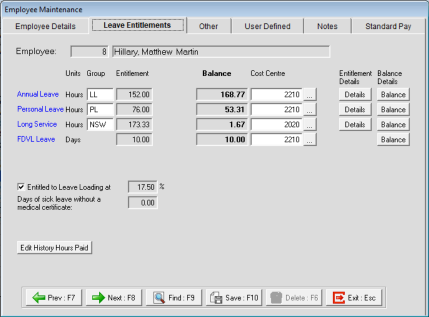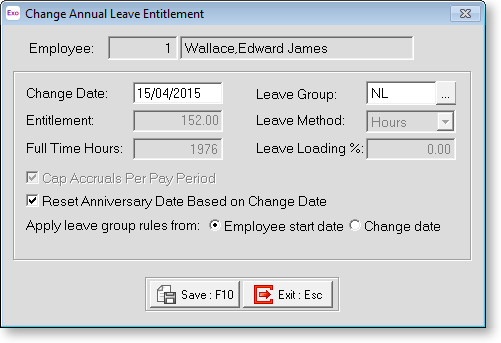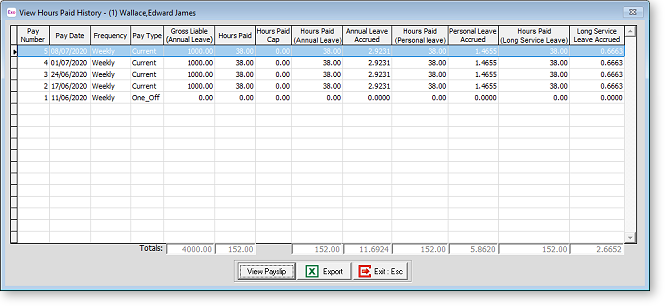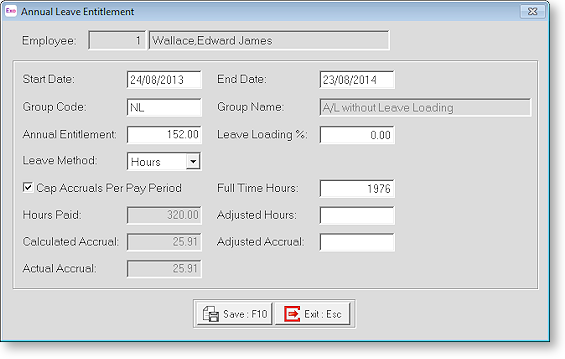Leave Entitlements Tab - New
The Leave Entitlements tab of the Employee Maintenance window contains the employee's entitlement to Annual Leave, Personal Leave and Long Service Leave. While it is not necessary to load the data in this window before you start paying your staff, it is recommended. All future activity on this particular window will be handled automatically by the program, although a number of the fields can be maintained manually to override information. This allows the fields to be changed if the leave data is incorrect. Some figures on this window (showing in a grey background) are computer-calculated as a result of the entries made elsewhere.
These figures are separate and different from the Tax year figures.

This topic describes the new leave entitlement management functions. Click here for documentation on the old functions.
Leave type rows
These four lines display this employee's entitlements for annual, personal, long service, and family domestic violence leave (FDVL). The following properties are available for each leave type.
Personal Leave includes both sick and carer's Leave.
Group You can attach a Leave Group code to each employee for Annual, Personal and Long Service leave (but not FDVL). Note that it is not compulsory to assign a group - you can still enter the appropriate rules manually. However, groups are a more efficient method of assigning awards to specific employees.
Entitlement Units The number of units that the employee is to receive on their next entitlement date.
Leave Method The accrual method used for the leave type: Calendar or Hours.
Entitlement Details Click one of the Edit buttons in this column to view, add and edit entitlement details for each leave type.
Balance The value in this field is calculated as follows:
- Annual Leave: Carry Over + Year to Date - Accrued Leave Taken
- Personal Leave and Long Service Leave: Carry Over + Current Accrual - Accrued Leave Taken
- FDVL: Entitlement Days - Accrued leave taken
Cost Centre If you use a specific Cost Centre for leave, this can be entered here and will be the default when paying the leave.
Direct Cost This option is available if Mixed proportional costing is enabled in the Payment Setup section of the Setup Payroll window. Ticking this option means that the leave value is costed directly to the specified Cost Centre.
Balance Details Clicking Balance in this column opens a window with the balance details for that leave type. For FDVL Leave, you can also define how FDVL appears on the employee's payslip and how it's reported for Single Touch Payroll (STP).
Leave Details
Click one the of Details buttons in this column to add or edit leave entitlements.
Change Group
Normally, rollover dates for leave entitlements are set automatically based on the employee's Anniversary Date, as displayed on the Employee Details tab. In some cases, it may be necessary to change the anniversary date that applies to an employee's leave entitlements, e.g. if an employee changes from a casual employee to a permanent employee, they will begin accruing leave from the date they became a permanent employee, not the date when they were first employed. To change the details of an employee's anniversary date and/or leave group, click the Change button in this column to open the Change Leave Entitlement window for the appropriate leave type:

This window is available for Annual Leave and Personal Leave only. Leave groups for all leave types can be changed by entering a new entitlement on the <span class="NoteLink">Leave Entitlement window</span>.
Change Date The date when the change to the employee's details was made. This defaults to today's date.
Entitlement The number of units that the employee is to receive on their next entitlement date.
Full Time Hours The number of full time hours the employee works in the entitlement period.
Leave Group By default, this option displays the leave group that the employee currently belongs to. Select the leave group to change the employee to.
Leave Method The leave accrual method currently used.
Leave Loading % If the employee has been awarded leave loading, the percentage rate will be displayed here.
Cap Accruals Per Pay Period This field corresponds to the Cap Accruals Per Pay Period setting on the Click here0 or Click here1 window.
The Leave Method, Leave Loading % and Cap Accruals Per Pay Period options are taken from the employee's leave group; they reflect the leave group's settings at the time the employee was added to the group. It is possible that the leave group has been edited since the employee was added, in which case the settings displayed here could differ from what is currently in the group.
Reset Anniversary Date Based on Change Date This option is available for Annual Leave only. If this option is ticked, the employee's Anniversary Date is updated to be the same as the Change Date entered. If a past date is entered, the leave rollover date will be one year after the change date; if a future date is entered, the rollover date will be the change date.
For Personal Leave, the Anniversary Date is always updated to be the same as the Change Date.
Apply leave group rules from This option appears when Reset Anniversary Date Based on Change Date is ticked. Select whether to apply the new leave group's rules from the employees start date or from the Change Date.
Other Settings
Entitled to Leave Loading at % Most permanent employees are entitled to a leave loading; this is an extra percentage of the annual leave payment, paid in surplus to the leave payment itself, in order to offset the expected loss of overtime/incentives that the employee will experience while they are away from work. If the employee has been awarded leave loading, the percentage rate, as determined by the current Annual Leave entitlement entry, will be displayed here. When paying outstanding annual leave, the value of the annual leave taken will be increased by the percentage stated in this window. If the employee belongs to an Annual Leave Group, this field displays the percentage that was set for the group at the time the employee was added to it.
Maximum personal leave entitlement This value is displayed when Personal Leave is calculated on a Lump Sum basis, as set in the Click here2. It determines the maximum amount of Personal Leave the employee can accrue. If it is set to 0.00, no maximum will be enforced.
Days of sick leave without medical certificate This is a placeholder for the number of sick days taken by the employee, for which the payroll clerk did not sight a medical certificate. This figure is loaded into the Click here3 section of the Current Pay window, during the pay run.
View Hours Paid History This button opens the View Hours Paid History window, which displays read-only information on the employee's leave accrual history.

Clicking the View Payslip button generates a payslip report, showing the details of the selected pay. (You can also right-click on a pay and select View Payslip to generate a payslip for that pay.)
You can click Copy to copy all data on the window to the clipboard, so that it can be pasted into an external application, such as a spreadsheet.
Editing Entitlements
To review the currently established group rule, click the Edit button here to open the following window:

This window shows the leave accumulation history of the employee and also enables editing of this information. If you have attached a Leave Group to the employee, the window will be pre-populated with details from the Leave Group.
Default Leave Groups can be specified for new employees on the Click here4.
Click Add to add a new entitlement line or Edit to edit the currently selected line.

Start Date & End Date Enter the dates of the entitlement period. Entitlement periods cannot overlap. For Annual Leave, each period cannot be longer than one year.
For Annual Leave, when an employee reaches the end of an entitlement period, a new entitlement record will be created that duplicates the most recent record, with the start and end dates increased by one year. If entitlement changes have been set up for the employee's Annual Leave Group, these new system-generated entitlement records will also take into account entitlement changes that are timed for specific lengths of service, where they apply to Annual Leave.
For Personal Leave, when an employee reaches the end of the current entitlement period, the system will move to the next entitlement record, if one has been set up. New entitlement lines will regularly be generated across the years of employment based on a repeat of the final entitlement rule as configured in the Personal Leave Group, with the repeating nature indicated in the entitlement line edit screen.
For Long Service Leave, when an employee reaches the end of the current entitlement period, the system will move to the next entitlement record, if one has been set up. When an employee reaches the end of the final entitlement period, a new entitlement record will be created and populated based on the options selected in the Click here5.
Group Code Enter a group code to insert the group's details into the window. A group code is not required, and all details from the group can be altered if necessary - using a leave group is just an easy way of filling in the details.
Annual/Period Entitlement Enter the number of hours of leave that the employee will accrue over the period defined by the start and end dates.
Leave Loading % Annual Leave only. Most permanent employees are entitled to a leave loading. This is an extra percentage of the annual leave payment, paid in surplus to the leave payment itself, in order to offset the expected loss of overtime/incentives that the employee will experience while they are away from work. If the employee has been awarded leave loading, enter the percentage rate here, e.g. 17.50 for 17.5%. When paying outstanding annual leave, the value of the annual leave taken will be increased by this percentage.
Days Personal Leave and Long Service Leave only. The number of days in the entitlement period.
Leave Method Select one of the following accrual methods:
Calendar - This method averages the employee's entitlement over a calendar year, accruing a set portion every pay period. The calculation works by finding the proportion of the calendar year worked and applying it to the entitlement. For example, assume an entitlement of 160 hours. Having worked six months of a year, an employee will have accrued 80 hours. After having worked an entire year, the employee will have accrued the full 160 hours.
Hours - This method applies the number of actual hours paid against a standard working year (usually 1976 hours), to find a proportion of the year worked. It then applies that same proportion against the standard yearly entitlement (usually 160 hours).
Cap Accruals Per Pay Period This setting appears when "Hours" is selected for the leave method. When using the Hours method, it is possible for employees to accrue more than their entitled leave if they work more than the Standard Hours set on the Click here6. Select this option to prevent the employee from accruing more than their entitled leave.
Full Time Hours This field appears when "Hours" is selected for the leave method. Enter the number of hours that the employee would theoretically be paid for if they were to work full-time for the whole year (this is usually 1976 hours).
Hours Paid This read-only field appears when "Hours" is selected for the leave method. It displays the number of hours the employee has currently worked during the entitlement period.
Adjusted Hours This setting appears when "Hours" is selected for the leave method. Enter a value here if you need to manually adjust the hours. Enter a positive amount to add hours or a negative amount to subtract hours.
Accrued to Date This read-only field appears when "Calendar" is selected for the leave method. It displays the date the accrual is calculated up until.
Calculated Accrual The amount of accrual calculated by the system, based on the selected accrual method.
Adjusted Accrual Enter a value here if you need to manually adjust the calculated accrual amount. Enter a positive amount to add to the calculated accrual or a negative amount to subtract from the calculated accrual.
Actual Accrual The final accrued hours amount for the employee, calculated as Calculated Accrual + Adjusted Accrual.
Changing the values on this window will not cause the read-only fields to update immediately. After you have made edits and clicked Save, the system will recalculate the accrued leave for all pays in the current year. If you open this window again, the read-only fields will display the updated values.
Change Carry Over
When completing your initial system setup, you will usually have existing employees with leave balances to transfer to Exo Payroll. To enter these balances, or to change carry-over details at a later time click the Change Carry Over button.
Carry Over Annual and Personal Leave only. This is the balance you are carrying over from previous entitlement years.
Hours Prior to 16/08/1978 Long Service Leave only. Accruals prior to 16 August 1976 that have not yet been taken by the employee. If you are new to this system it is important to load any entitlements still owing, from your previous records.
Hours between 16/08/1978 and 17/08/1993 Long Service Leave only. Accruals between 16 August 1976 and 17 August 1993 that have not yet been taken by the employee. If you are new to this system it is important to load any entitlements still owing, from your previous records.
Hours after 17/08/1993 Long Service Leave only. Accruals after 17 August 1993 have not yet been taken by the employee. If you are new to this system it is important to load any entitlements still owing, from your previous records.
Year-To-Date Accrued This field appears for Annual Leave only. It is the automatically calculated balance for the current entitlement year.
Current Accrual This field appears for Personal Leave and Long Service Leave. This is the automatically calculated balance for the current entitlement period.
Total Hours This is the total hours the employee is entitled to. When transferring balances from your previous payroll system, you will most likely need to adjust the Total Hours. Do this by editing the Carry Over field - enter a positive value to increase the total or a negative value to decrease it.
Current Period This is the period that the leave balance applies to.
Toolbar Buttons
In addition to standard buttons for adding, deleting, etc. the following special purpose buttons are available on the toolbar at the bottom of the window:
- Copy - copies all data on the current tab to the clipboard, so that it can be pasted into an external application, e.g. a spreadsheet.
- Pay History - opens the Click here7.
- Change Group - opens the Click here8.

